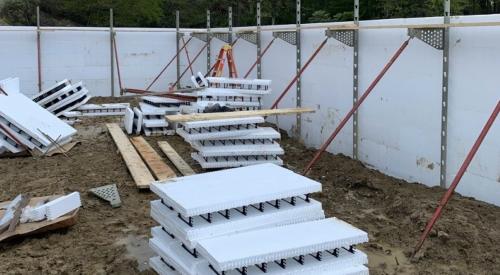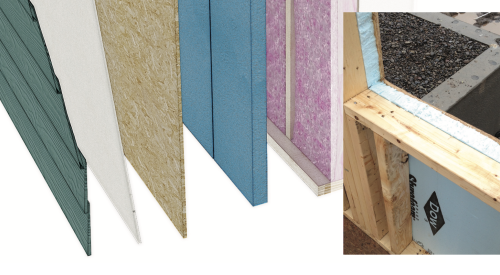|
An increasing number of homes are built with concrete walls every year — up from 3 percent to more than 16 percent over the past decade, according to the National Association of Home Builders. Concrete walls offer customers greater comfort, lower energy bills, termite and moisture resistance and superior resistance to fire and wind.
 |
Thermal mass walls consist of 4 inches of concrete facing the interior, 2 inches of concrete on the exterior and 2 inches of Styrofoam extruded polystyrene board insulation sandwiched in between. Fiber composite connectors, spaced 16 inches on center, hold the assembly together.
"These plastic connectors are one of the keys to the energy efficiency of the T-Mass walls, says John Gajda of Construction Technologies Laboratory. "Others systems use steel connectors, which readily conduct heat. Steel connectors greatly reduce the R-value and reduce the energy efficiency of the walls."
Thermal mass walls come in two forms: precast and poured. Precast panels are manufactured at a plant and delivered to the job site.
Thermal mass walls take advantage of the thermal mass effect, which occurs when concrete walls and floors absorb daytime heat and release it at night. During the daytime, the 4 inches of interior concrete warm up to the indoor temperature. Once the home's interior temperature falls below the wall temperature, the concrete releases this heat back into the home.
This effect reduces both cooling and heating loads, allowing builders to downsize equipment. Along with decreasing the total amount of heating and cooling required, it also shifts the load to off-peak hours, which can offer even greater cost savings in areas with variable electricity rates.
Although the wall has a material R-value of 11.33, its effective R-value — which considers the thermal mass and other effects of the concrete — can be two to three times as high depending on the climate.
The extent to which the thermal mass effect increases the effective R-value of a wall is affected by the number of heating degree-days. The general rule is that areas with fewer heating degree-days will benefit more from the thermal mass effect.
The Partnership for Advancing Technology in Housing (PATH), a program of the U.S. Department of Housing and Urban Development, has found through numerous site demonstrations that thermal mass walls offer significant savings on energy bills, especially throughout the south and in the west.
Oak Ridge National Laboratory's 2001 research on the energy efficiency of 16 different wall configurations (including stick frame, T-Mass, and ICFs) confirms this finding. The study, Thermal Mass — Energy Savings Potential in Residential Buildings, shows that concrete thermal mass walls, "applied in good contact with the interior of the building," are the most efficient wall assembly.
In 2004, students and researchers at the University of Nevada, Las Vegas, approached Pinnacle Homes to help them build a zero net energy, 4500-square-foot home. After examining various aspects of the design, Pinnacle chose thermal mass walls because of their energy efficiency.
"Homeowners are always looking for savings, and they are looking for predictability in their energy bills," says Frank Wyatt, president of Pinnacle Homes in Las Vegas. "We wanted to try the technology to see if we would like it."
Quieter, More Durable Homes"It's a very energy-efficient wall, but in addition to that, I also like the panels because they are very durable," says Wyatt.
In regions that experience frequent natural disasters, the disaster resistance and durability of T-Mass walls may be very appealing. Concrete-filled T-Mass walls withstand damage from tornados, hurricanes, fire and termites better than stick-frame walls. As a result, many insurers offer lower insurance premiums on homes built with this technology.
For homebuyers in humid climates, the moisture resistance of thermal mass walls may be especially attractive. "The foam does not readily absorb much moisture," says Federico Montaner of Dow. "When you combine that with the inherent cavity-less construction of a T-Mass wall, there is no place for the growth of mold and mildew."
T-Mass walls are also very quiet since the dense concrete and foam core combine to provide better soundproofing.
Another benefit of concrete walls is that they make it easy to apply quality finishes like stucco. "You can stucco the exterior layer of concrete without any preparation, which gives you a nice, durable outer covering," says Wyatt.
Not only is it easy to apply stucco, concrete's superior moisture resistance helps ensure the longevity of the finish.
"Synthetic stucco over a framed wall can have serious moisture problems," says George Flavel, a custom homebuilder in Northfield, Minn., who built a 4200 square foot poured concrete home for his personal residence.
"Insurance companies won't even insure that type of construction anymore," Flavel says. "With a concrete and polystyrene sandwich wall, you don't have to worry about moisture." However, many insurance companies actually offer a disaster-resistant construction discount for concrete walls.
Builders can package many of these benefits as green for environmentally concerned homebuyers. Concrete thermal mass walls are not only highly energy efficient and conducive to healthy indoor air, but homes built with thermal mass walls require substantially less lumber and produce less construction waste than stick-built homes.
Built in a DayWhile T-Mass walls cost more than wood, they also go up faster. Factory-fabricated panels are shipped to the site, lifted into place by crane and then assembled. Using this method, Wyatt says Pinnacle erected the exterior walls for the zero-net-energy home in eight hours.
Even though this was the first home he built with precast T-Mass, he reports that it was easy to use. But he cautions that since the walls are precast, the panels are not flexible enough to allow for last-minute changes. "If you can't stick with your design, then you will have walls that you can't use," says Wyatt.
Poured-in-place T-Mass walls do maintain design flexibility, but they are mostly used in below-grade applications. With this system, the concrete is poured into traditional forms once the insulation and connectors are in place.
CostsTypical prices of thermal mass walls appear to increase the final cost of a home by about 15 percent compared to wood-frame construction. "This is a hard number to get a handle on," says Mark Mercurio, vice president of Custom Concrete Structures (CCS). CCS builds custom homes and small commercial buildings with prefabricated thermal mass walls throughout the mid-Atlantic.
"When you look at the wall initially, you say, 'My gosh, the price!' But you really have to dissect the house to see where you can save, and most builders have a hard time doing this."
Given the extra up-front cost, T-Mass is probably most cost-effective for builders of mid-level and high-end homes.
|










